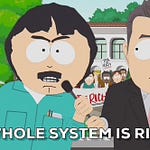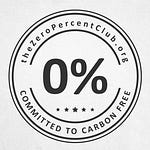Hello!
In this post, I dive in to atmospheric carbon taxation as it exists in the world today, and what major initiatives are underway presently. Over the course or the research, I became pleasantly surprised with the extent in which systems are in place, and the rate of growth evidenced — mostly outside the U.S..
As the European Union has for a long time had the world's most extensive Carbon Tax, I start by with a preface about Ukraine and the EU as a (hopefully fun) tangent which explores the workings of EU power structures. You can skip over this if just interested in Carbon.
Standards Bodies
What is humanity’s most powerful self-organizing tool? I believe it might be standards bodies. Here’s how I interpret the term:
A standards body is a focused group of one or more people dedicated to the creation of a set of rules which may be followed at large, either voluntarily or by force. A standard can have as wide an effect as a national regulation or be as small as a household rule for dinner time.
Standards affect every aspect of our lives. They define how web browsers choose to display web-pages, give us decentralized email as a backbone of the internet age, allow money to move around the world, allow you to plug in a printer, and the list goes on.
This is a field which benefits greatly from a careful study of human incentives, and when the rules are right, can have a strong positive effect. I think two things are important for any standard
A rule should accurately reflect reality - such as by internalizing and externalized pain, in order to tighten a feedback loop
When the rule is “exploited” by humans with intentions not matching those of the authors, a positive outcome still results.
Throughout this post, keep those two in mind as a litmus-test for well-designed policy.
Ukraine’s Accession to the EU
As the world has watched the war in Ukraine unfold, a continual theme has been Ukraine’s membership in the EU. A close look at what changes are required by Ukraine reveals the power of EU standards.
The Istanbul Convention
The Istanbul convention, signed in 2011, is “the first legally-binding instrument which ‘creates a comprehensive legal framework and approach to combat violence against women’ [It] is focused on preventing domestic violence, protecting victims and prosecuting accused offenders”.
In summary of the wiki section: Ukrainian leaders have been trying to ratify the Istanbul convention since 2011, but faced opposition in parliament (apparently largely due to churches and some politicians disliking the use of the term “gender”). This passed in 2022 due to an increase in crimes in the occupied territories, and due to increased political will to join the EU.
WTH is Anti-Corruption Law Anyway?
For over two decades, Ukraine has consistently ranked ~120 out of 180 most corrupt countries. The EU requires that members have in place “Anti-Corruption” measures. But what does this mean exactly, and how can you actually fight corruption without getting corrupted?
Well, there’s a French-based organization called the Group of States against Corruption, or GRECO, with 50 member states, including the EU states, the US, and others. They run a periodic round-based evaluation process whereby officials investigate and then rank a given country. A passing grade here is typically required for EU membership.
Reports are typically publicly published after some months delay for evaluation, and I took a look at the Ukraine 2021 report (published on the Council of Europe website).
If you’re inclined to read it yourself, here’s a couple of tips: 1) each recommendation has a premise in italics, followed by an evaluation from GRECO, a response paragraph, an acknowledgement, and a final grade. 🟠 An emoji grading system would really liven it up. To make things easier, you can 2) jump to the conclusions on page 26, which form a bit of an executive summary.
Key sections include:
Judicial review (removing laws that could criminalize judges based on their verdict, providing physical security such as guards)
Parliamentary review (disclosure of assets, separation of entrepreneurial concerns, broadcast meetings and publicly posted plans), and
Prosecutorial office changes (adoption of concrete & actionable ethics standards & self-recusal standards, appeals for promotions or dismissals, and random assignment of cases).
And in conclusion:
Ukraine has implemented satisfactorily or dealt with in a satisfactory manner nine out of the thirty-one recommendations contained in the Fourth Round Evaluation Report.
For those eager for Ukraine’s admittance, perhaps this should give some pause. I for one will be eager to see the 2022 report when it is released.
In a narrative of international organizations from the past 100 years such as the League of Nations, the United Nations, and many Continental Unions, the EU forms the world’s only Supranational union — where governance by the union can take precedence over national government.
Designed to entice Iron Curtain countries, it is this hard power which makes the union scope anti-corruption legislation enforceable, and this same power which gives membership such strong value.
I can’t be alone in thinking it is a shame that such a powerful and novel anti-corruption force is self-limited to just a single continent.
Carbon Taxes As They Exist Today
A Carbon tax usually has two components: a bit which charges a fee for emitted carbon, and a bit which spends that money in a way which boosts the economy. There are many ways to implement these two components. Fees can be charged through carbon credits carbon price fixing. Money can fund decarbonization efforts or backlogged local issues. Despite the variety, it seems any sub type is better than no regulation at all, and the selection largely comes down to political ideology and implementation skill.
“Cap and Trade” is perhaps a familiar term, and indicates a prescribed budget for corporate emissions, after which companies must purchase or sell allotments on an open or closed marketplace. This has gotten pushback sometimes for allowing emitters to skate by, but as we’ll see, that fear is lifted with a properly maintained system. Here’s a quick video introducing the idea of cap and trade:
For the past decade, the European Union has been leading the world with their Cap-and-Trade / Emissions Trading System. Let’s see how it works and then compare it to the rest of the world.
Europe’s Emissions Trading System (EU-ETS)
Since 2005, the European Union has been operating a cap-and-trade emissions marketplace. Any factory emitting carbon must purchase allotments at a government auction in order to do so. The revenue goes to a decarbonization budget distributed among member countries.
Unlike a fixed-price carbon tax, the price fluctuates according to free-market forces of supply and demand. Interestingly, speculators and investors have market access (this is not the case for all ETS markets), which have the Jekyll and Hyde effects of both smoothing volatility and creating it, at different times and for different reasons.
The goal is to transition Europe away from fossil fuels, and the belief stated in the report is that by being a world leader and driving domestic innovation, Europe will have a strong competitive advantage in the long term.
Every 2-3 years the governing body revisits how the system is working, and tune parameters which affect the market dynamics — much like the management of any other economic currency system (such as the U.S. Monetary Supply). These parameters include:
The total amount of carbon allowed to be emitted in Europe each year (specifically: the rate this decrements annually)
The amount of “free allocations” given out to keep European industry competitive with international industry
(Since Phase 4) The operations of their “Stability Reserve” in buying and selling surplus allotments.

The April 2022 Annual Report describes the 2013 rollout as first cautious with many “free allocations”, a gradual per-year reduction, and a corresponding weak effect on emissions. As economic and political reactions have stabilized, the free allocations have been decreasing and rate of scarcity increasing. The report is careful to point out that their approach encourages stable markets, and recent energy spikes can be attributed to other causes.
A couple of cases illustrate the effects of carbon pricing.
We can read a short 2020 interview with the CEO of a Swedish net-zero steel plant which was supportive of ETS, but was of the opinion that it didn’t go far enough.
According to the report, increased demand for coal in 2022 has pushed up both the price of coal (orange) and the cost of carbon permits, but the permit price was not sufficient to drive a switch to natural gas due to high prices there as well. (However, war with Russia made a nudge.)
Where the money goes
€14B is raised annually at 2020 rates, of which 70+% is budgeted towards emissions reductions. For comparison — this is 1.4% of the quoted €1 Trillion which Europe needs annually to hit net-zero by 2050.
Where the funds are spent is particularly important because a carbon tax, which affects the cost of all goods and services in a broadly inflationary manner, is considered to be regressive. (Having an outsized impact on the lowest income earners).
Particularly countries from Northern and Southern Europe used the funds mainly to develop renewable energy to meet the EU’s target, while Central and Eastern European Member States gave preference to encouraging a shift to low-emission and public forms of transport. Countries from Eastern Europe invested in energy efficiency measures.
We commonly highlight (including in my previous post) Co2e-per-kWh, but that does short shrift to investments in reducing energy usage. In one measure, Germany (580g/kWh) is 4-8x worse than France (66-148g/kWh). However on a per-capita basis, they are “only” about twice as GHG-polluting as France. Then again, your author’s home country comes in at a per-capita carbon cost three times that of France 🙄.
Last but not least EU-ETS funds a €38 Billion Innovation Fund and €48 Billion Modernisation Fund which are supporting entrepreneurship and infrastructure respectively. Unfortunately, I’ll have to await some future day to review their annual reports.
This is the end of Part I. Next week in Part II I will talk about some exciting developments in ETS and Carbon Taxes around the world, and then focus in on US policy.
Thanks,
–Peter

















Share this post